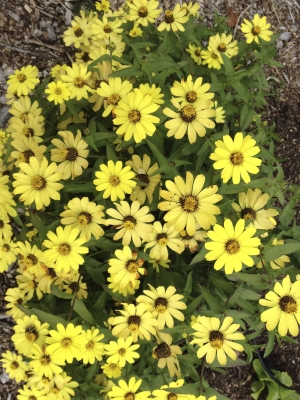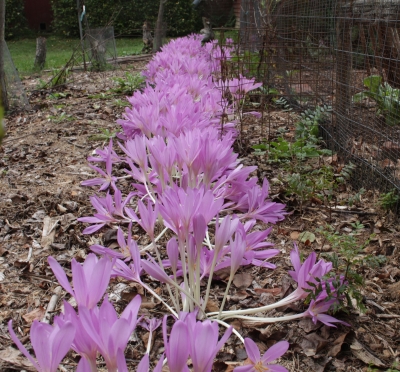FLOWERS FOR THE VEGGIE GARDEN
Zinnias In and Colchicum Outside
And the winner is . . . Every year boxes of plants arrive at my doorstep, sent by nurseries and seed companies hoping to wow me with their products which I will then praise and induce you all to purchase. Most of the plants turn out to be ho-hum, perhaps new but not necessarily better than what’s been around for decades. Not so this season, for a charming yellow flower that’s been blooming nonstop all summer long and offers no indication as yet of expiring.
That plant is . . . unfortunately I lost the label so have been sleuthing for days now to give this winning plant a name. It looks much like a zinnia, a single flowered zinnia, that is, one with a single row of petals. The plants are compact, a little more that a foot high and wide, and — very un-zinnia-like — show no signs of powdery mildew.
My first guess for the plant was creeping zinnia, which actually can be one of two different plants. The first is a true zinnia, Zinnia angustifolia, and the second is not really a zinnia; it’s Sanvitalia procumbens. After getting out my botany books (books!) and magnifying glass and staring at the peduncle, receptacle, and disk and ray flowers of a flower from my plant and comparing it with written descriptions, I was still scratching my head to give my plant a name.
In frustration, I went to the garage to my “miscellaneous” bucket into which I sometimes toss plant labels that I might need to reference again at a later date. Digging down deep amongst all shapes and sizes of labels, I came upon one printed “Zahara Yellow Improved Zinnia.” Back inside, on the web, comparing descriptions and photos verified that — yes — that’s the plant.
The botanical name listed for Zahara zinnias, which also come in other colors, is Zinnia Marylandica. That species name looks and is fake. Zaharas are interspecies hybrids, with some creeping zinnia (the Z. angustifolia c.z.) in their blood. So my guess at their being creeping zinnia was not far off.
Looking over at my conventional zinnias (Zinnia elegans) for comparison, they appear gawky witI their large flowers, both new and faded ones, prominently perched atop long stalks. Their many petalled blossoms look too full of themselves. Zahara buries its spent blossoms out of sight amongst new flowers and foliage of the compact plants.
Next year, I’m planting Zahara Yellow Improved Zinnias again.
A Vegetable Factory Functionally, But Not Visually
Those Zahara zinnias, planted along the main path of the vegetable garden joining arbored gates at either end, create two golden ribbons to draw you along the path. As I walk the path and glance left, north, I see, just outside the garden fence, another ribbon, this one a broad brush stroke of purple with not a hint of green. (More on that later.)
A vegetable garden need not be a vegetable factory. Too many look as if dropped from the sky, plopped down in the middle or far corner of lawn and enclosed with a strictly functional fence. Why not make the vegetable garden pretty and cozy it up near the house? Beds paint a two-dimensional design on the ground. A nice fence helps; even better if it integrates with the style of the home.
Vegetable gardens often look stark because of the abrupt transition between the vertical fence and adjacent, horizontal lawn. Decades ago, I regularly rototilled around the outside of my fence to keep weeds away from the fence line. I decided that was wasted space, so planted it with shrubs, flowers, and vegetables that didn’t need fencing. It was a good decision, softening the transition from garden to lawn.
So gussy up your vegetable garden with ornamental plants inside and out, with decorative fencing and arbors, perhaps an herb-lined path drawing you within, or perhaps with a bench, bird bath, or gazing globe as a draw.
And A Stripe of Purple to Gussy Up the North
That purple brush stroke north of my vegetable garden are the petals of autumn crocus, Colchicum autumnale. In contrast to the Zahara zinnias, autumn crocus has been cultivated hundreds of years, and my plants are run-of-the-mill species rather than any hifalutin variety.
Like Zahara zinnias, autumn crocus has nomenclature issues. To whit, it is not a crocus. Further complicating things, there are true crocuses that bloom in autumn, sometimes called autumn-blooming crocuses, among them the saffron crocus, Crocus sativa. Colchicum autumn crocus, my purple brush-stroke, is poisonous.
The purple of my autumn crocuses is so bold because leaves don’t accompany the flowers (again, in contrast to autumn-flowering crocuses, whose leaves appear with the flowers). Autumn crocus leaves are big and bold, appearing in spring and looking something like ramps, the edible wild onion species. In Europe, where both autumn crocus and a ramp-like relative, grow, people have been poisoned for mistaking one plant for the other.
But toxicity isn’t what keeps more people from planting autumn crocus. Daffodils, after all, also are toxic. The problem is timing: Autumn crocus bulbs are ready for planting in late summer, before daffodils, tulips, and other fall planted bulbs are ready. It’s hard for nurseries to get people excited about yet another bulb planting season, and only for this single species. If not planted soon enough, autumn crocus bulbs grow, even without soil. The bulbs multiply quickly and when I divided and replanted them last summer, I kept a few out, three of which now sit naked in a bowl on the dining table, blooming.




These “crocuses” are lovely, and at a time when I could use some vivid color aside from mums and asters–they’re too tall for my needs anyhoo….do you consider these worth planting for fall color? I guess you do, since you are writing about them, but how long do the blossoms last, and do they hold up to fall weather up here in the Adirondacks? They look a bit delicate, and after a rain could end up in a violet soupy mush.
Yes, they the autumn crocus blossoms do look delicate. But they’ve been blooming for over a month! They’re definitely worth planting, looking good even when flopped on the ground. And they multiply fast (but not too, too fast).
Hi Lee, Did you ever saw any honeybees on your zahara zinnias? I planted some orange ones with the elegans variety. I’m a beekeeper. I noticed honeybees and other pollinators on the elegans but not on the Sahara.
Thanks. Cheryl
Offhand, I did not remember noticing honeybees on them but that doesn’t mean they weren’t there.
Beautiful! I love the flower laden path in your vegetable garden. It begs to be walked down and upon. I plant many flowers among my vegetables – and bonus if they’re edible – but mainstays are nasturtium (which I see you also have), calendula and borage. But my paths are usually grown over by this time of year and barely passable. I always enjoy the strict neatness of your garden! It is so admirable and I am certain much more productive than mine. I also planted Lemon Tagetes this year (from seed) – they are still in full bloom and look wonderful much like those improved zinnias – another keeper that I’ll plant again and possibly those improved zinnias, too. I LOVE your “crocus” – colchicums have been on my wish list for a couple of years now. I keep seeing these dense drifts of purple like yours everywhere – it is reinforcement.
I also am a big fan of Lemon Gem marigolds although I have trouble germinating the seeds. Do you?
Zinnias have come a long way. I grew ‘double yellow’ profusion zinnias this year as filler in our patio garden. It was not bothered by insects, never needed dead-heading and was full of blooms continuously. Easiest flowering plant I’ve seen, and since I’m primarily a vegetable and berry gardener, their ease of care was a big plus.
What a coincidence! I just posted about my Zinnia linearis which is similar to the zinnias you have in your garden. Mine are grown from seed, still blooming, and no powdery mildew. I see an article about zinnias in the future, especially plants that don’t get powdery mildew in our hot/humid Virginia gardens
We introduced Zahara Sunburst from Burpee to one of our flower beds this year and loved it as well. It will definitely be a repeat.
What strength magnifying glass do you recommend for gardeners?
It seems like most of the 10x reviews on amazon for magnifying glasses are pretty low.
Is there a classic metal rim magnifying glass that you recommend?
I have a 14x that says “Bausch & Lomb” and “Coddington” on it. Very good.